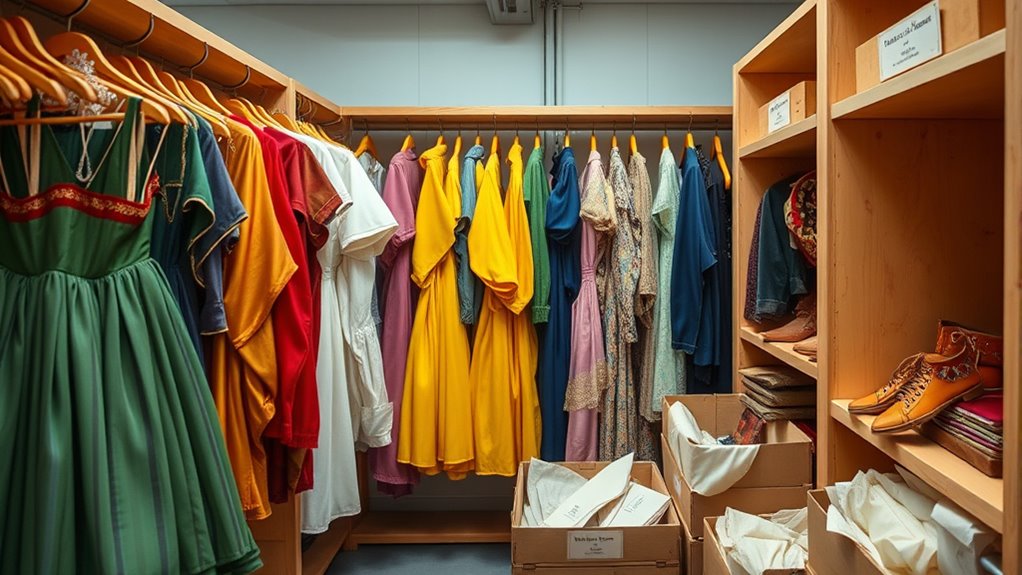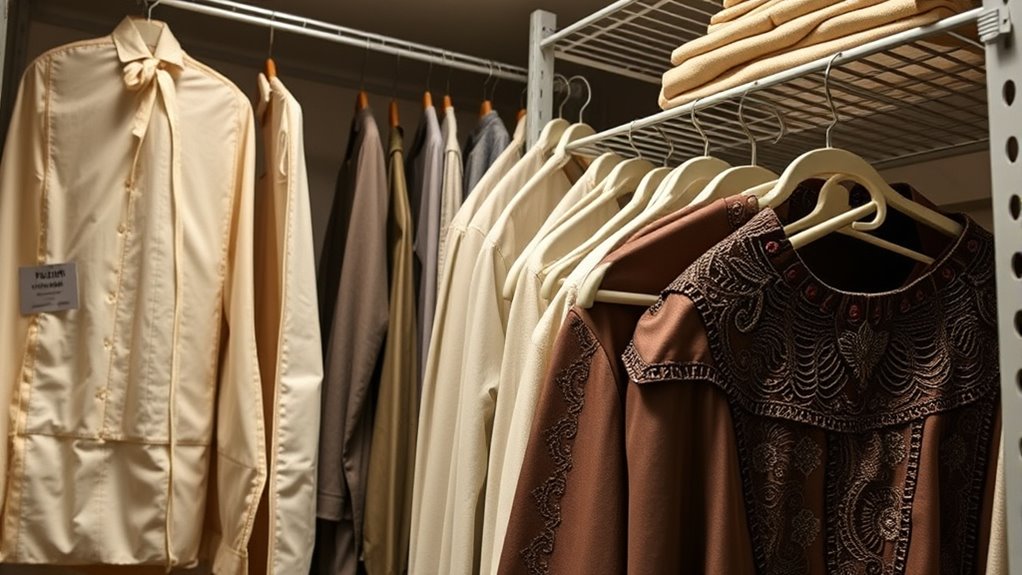To store and maintain costumes for reuse, select breathable containers like cotton or muslin for delicate pieces, and sturdy plastic with airtight seals for durable items. Handle fabrics gently, using padded hangers or flat storage with acid-free tissue to prevent damage. Keep costumes dust and pest-free by using natural repellents and regular inspections. Proper cleaning before storage and seasonal adjustments help prolong their lifespan. If you continue, you’ll discover more tips to keep your costumes in top condition.
Key Takeaways
- Use breathable, acid-free containers or garment bags to protect costumes from dust, pests, and humidity.
- Handle fabrics gently, store on padded hangers or flat with acid-free tissue, avoiding stacking or wire hangers.
- Incorporate natural repellents like cedar or lavender and regularly inspect storage for pests or mold.
- Clean costumes thoroughly before storage, ensuring they are dry and properly folded or hung to prevent damage.
- Schedule routine inspections and maintenance, including cleaning, repairing, and updating records for easy reuse.
Choosing the Right Storage Containers for Costumes

When selecting storage containers for costumes, choosing options that protect your garments from dust, moisture, and pests is essential. The right containers help guarantee fabric preservation and maintain the quality of your costumes over time. Opt for breathable materials like cotton or muslin bags for delicate or valuable pieces, allowing air circulation and preventing mold. For more durable items, sturdy plastic containers with tight-fitting lids can provide a sealed storage environment against moisture and pests. Avoid cardboard boxes, which can attract pests and absorb humidity. Additionally, consider containers that are acid-free to prevent fabric deterioration. Properly chosen storage containers create a stable environment, safeguarding your costumes from environmental damage and keeping them in excellent condition for reuse. Incorporating quality assessment techniques can help ensure your storage solutions meet the necessary standards for long-term preservation.
Proper Folding and Hanging Techniques to Prevent Damage

Proper folding and hanging techniques are essential for preventing damage to your costumes during storage. When folding fabric, handle it gently and follow natural creases to avoid stretching or fabric distortion. Use smooth, even folds to prevent unnecessary stress on delicate materials. For hanging, selecting the right hanger is vital; opt for padded or wide-shouldered hangers that support the costume’s shape and prevent shoulder bumps. Avoid wire hangers, which can cause fabric indentations or tears. Make sure the hanger size matches the costume’s shoulders to prevent stretching. Always hang costumes in a way that minimizes creases and maintains their form. Properly folded or hung costumes stay in better condition, ready for reuse without damage. Additionally, storing costumes in a breathable garment bag can help protect them from dust and pests while maintaining their integrity.
Protecting Costumes From Dust, Moisture, and Pests

To keep your costumes in top shape, you need to protect them from dust, moisture, and pests. Using dust-resistant storage containers and creating a pest-repellent environment can make a big difference. These simple steps help preserve your costumes and extend their lifespan.
Dust-Resistant Storage Solutions
Dust, moisture, and pests can quickly damage costumes if they aren’t stored properly. To keep your costumes pristine, invest in dust-resistant storage solutions. Use sealed garment bags or airtight containers to protect fabric dyeing and delicate fabrics. Clear storage bins make it easy to see your costumes during costume display, reducing handling and minimizing dust exposure. Consider adding moisture absorbers like silica gel packs to prevent humidity damage. Elevate costumes off the ground to avoid pests and dampness. Regularly inspect your storage for signs of pests or dust buildup. Properly sealed and organized storage keeps your costumes ready for reuse, maintaining their quality and appearance over time. Using optimal angles for pinball machines can also help prevent accidental damage during handling. With these steps, your costumes stay protected and perfect for future performances.
Pest-Repellent Environment
Creating a pest-repellent environment is essential for safeguarding your costumes from damage caused by pests, dust, and moisture. To do this, use natural repellents like cedar chips, lavender sachets, or herbal sachets, which deter insects without chemicals. Store costumes in pest-proof containers made of plastic or airtight fabric covers to prevent pest entry and moisture buildup. Keep the storage area clean and dry, as pests thrive in damp environments. Regularly inspect your costumes for signs of pests or mold, and replace natural repellents every few months for continued effectiveness. Additionally, proper storage techniques help maintain the quality and appearance of your costumes over time. By combining natural repellents with pest-proof containers and maintaining a clean space, you create a protective environment that preserves your costumes for reuse and prevents damage over time.
Handling Delicate Embellishments and Decorations

How can you guarantee delicate embellishments and decorations stay intact during storage? The key is careful handling to assure embellishment preservation and decoration safeguarding. First, place costumes with fragile adornments in acid-free tissue paper to cushion them. Second, store these items flat or hang them using padded hangers to prevent sagging or distortion. Third, keep them in breathable garment bags to avoid dust buildup and moisture damage. Avoid stacking costumes, which can crush or loosen embellishments. Regularly inspect items for any signs of damage, and handle decorations gently when moving or cleaning. Additionally, understanding proper material care techniques, such as avoiding exposure to excessive heat or direct sunlight, helps maintain the integrity of delicate embellishments. By taking these precautions, you protect intricate details and maintain the costume’s original look, ensuring your embellishments stay beautiful and secure for future reuse.
Organizing Costumes for Easy Access and Inventory Management

To keep your costumes accessible and organized, start by categorizing them clearly—group similar styles or themes together. Implement an inventory tracking system to know exactly what you have and where it’s stored. This way, you can quickly find what you need and avoid losing track of costumes over time. Incorporating a systematic approach to organization can further streamline your costume storage process and improve efficiency.
Categorize Costumes Clearly
Organizing costumes with clear categories is essential for easy access and efficient inventory management. Proper costume categorization helps you quickly find what you need and keeps your storage neat. Start by grouping costumes based on themes, occasions, or characters. Use consistent storage labeling to identify each category clearly. This organization approach is similar to inventory management practices used in retail and warehousing, ensuring everything is systematically stored and easily locatable. Consider these tips:
- Separate costumes by type, such as formal wear, accessories, or masks
- Use descriptive labels for quick identification
- Keep frequently used costumes accessible and less-used items organized separately
Implement Inventory Tracking
Implementing an effective inventory tracking system is essential for maintaining easy access to costumes and managing your collection efficiently. By using a digital inventory, you can quickly locate items and monitor their status. Barcode tracking simplifies this process, allowing you to scan costumes during storage or retrieval, reducing errors. Organize your collection with clarity, assigning each costume a unique barcode, and log details like size, condition, and costume type. Use the table below to visualize your tracking system:
| Costume Name | Barcode Number | Location | Status | Notes |
|---|---|---|---|---|
| Pirate Costume | 001234 | Shelf A | In Use | Needs cleaning |
| Fairy Dress | 005678 | Shelf B | Stored | Perfect condition |
| Vampire Cloak | 009012 | Shelf C | In Repair | Missing buttons |
| Clown Outfit | 003456 | Shelf D | Stored | Slight stain |
| Cowboy Gear | 007890 | Shelf E | In Use | Recently cleaned |
This system streamlines costume management, ensuring quick access and organized storage. Additionally, maintaining accurate records can help enhance inventory accuracy and streamline future reusing or restoring efforts.
Cleaning and Care Tips Before Storage

Have you ever wondered if your costumes are truly clean before storing them? Proper cleaning guarantees they stay in good shape and prevent damage. Start by inspecting your costume for stains or dirt. Use a gentle costume detergent to remove residues effectively. Avoid fabric softeners, as they can leave buildup that damages delicate fabrics. When washing, follow the care label instructions carefully. After cleaning, air dry costumes completely in a well-ventilated area to prevent mold and odors. Incorporating mindfulness techniques during the cleaning process can help you stay present and attentive to detail. Here are some quick tips:
- Remove all dirt and stains before storing
- Use mild detergents designed for costumes
- Skip fabric softeners to preserve fabric integrity
Using Acid-Free Materials to Preserve Fabric Quality

After ensuring your costumes are clean and dry, the next step is to protect their fabrics from aging and deterioration. Using acid-free materials for storage is essential for acid-free preservation, which helps prevent fabric yellowing and weakening over time. Choose acid-free tissue paper to stuff garments and wrap delicate pieces, maintaining their shape and preventing creases. Store costumes in acid-free boxes or archival-quality storage containers to provide a neutral environment that reduces acid migration. These materials help extend fabric longevity by minimizing exposure to harmful acids and environmental factors. Avoid using regular cardboard or plastic bags, which can accelerate deterioration. Additionally, proper clothing storage techniques can significantly enhance the preservation process. By carefully selecting acid-free storage options, you guarantee your costumes remain vibrant and intact for future reuse.
Seasonal Storage Strategies for Costumes Not in Frequent Use

When storing costumes that you don’t wear regularly, planning ahead makes sure they stay in top condition until next use. Seasonal cleaning is essential before storage—remove dirt, dust, and stains to prevent damage. Carefully choose a storage location that’s cool, dry, and away from sunlight to avoid fading or fabric deterioration. Consider using breathable garment bags or sturdy containers to protect costumes from dust and pests. Additionally, monitoring seasonal climate conditions can help prevent fabric damage over time.
Regular Maintenance and Inspection to Prolong Costume Longevity

Maintaining your costumes regularly helps guarantee they stay in great condition for future use. Routine inspections catch issues early, preventing damage and extending their lifespan. Implement a costume rotation schedule to avoid overuse of any single piece, reducing wear and tear. Seasonal maintenance is also essential; clean and repair costumes after each season to remove dust, stains, or damage. Use the table below to guide your upkeep:
| Task | Frequency | Tips |
|---|---|---|
| Inspection | Before and after use | Check seams, fabric, accessories |
| Cleaning | After each season | Hand wash or gentle cycle |
| Repairs | As needed | Sew rips, replace missing parts |
Regular care keeps your costumes looking fresh and wearable for many seasons. Additionally, inspecting costume accessories regularly ensures all components remain secure and functional.
Frequently Asked Questions
How Can I Prevent Color Fading During Storage?
To prevent color fading during storage, you should focus on fabric protection and color preservation. Store costumes in a cool, dark place away from direct sunlight, which can cause fading. Use acid-free tissue paper to wrap the fabric gently, preventing friction and color loss. Additionally, verify the storage area has low humidity and good airflow. Regularly check your costumes to spot any signs of fading or damage early.
What Are the Best Methods to Repair Minor Costume Damages?
Don’t wait for a problem to snowball—address minor costume damages early. First, carefully assess the damage to understand what needs fixing. Then, gently clean the costume to remove dirt and debris. Use needle and thread to repair small tears or loose seams, and fabric glue for quick fixes on embellishments. These simple steps keep your costume looking great and extend its lifespan, ensuring you’re ready for your next performance.
How Do I Safely Store Costumes With Intricate Accessories?
To safely store costumes with intricate accessories, you should carefully fold the costume to prevent wrinkles and damage. Use separate compartments or small boxes for accessory organization, ensuring each piece is protected from crushing or tangling. Keep delicate accessories away from heavy items and consider using tissue paper to cushion fragile parts. Regularly inspect and gently clean your costumes to maintain their condition for future reuse.
Can I Store Costumes in Plastic Bins Long-Term?
Yes, you can store costumes in plastic bins long-term, but first, identify the costume material to guarantee compatibility. Use clear, sturdy costume storage containers to keep your costumes protected from dust, moisture, and pests. Make sure the bins are breathable or include ventilation. Fold delicate items carefully, and consider adding acid-free tissue paper to prevent damage. Proper storage helps preserve your costumes and keeps them ready for future use.
What Climate Conditions Are Optimal for Costume Preservation?
You should keep your costumes in a climate with stable temperature and humidity control. Aim for a cool, dry space where temperature stays between 65-70°F and humidity stays around 50%. Fluctuations can cause fabric deterioration or mold growth. Avoid attics or basements with high humidity or extreme temperatures. Proper climate conditions help preserve your costumes’ fabric, colors, and details, ensuring they stay in great shape for reuse.
Conclusion
By following these storage tips, you’ll turn your costume collection into a well-organized treasure chest that stays vibrant and ready for any occasion. Think of your costumes as precious gems—you’ll want to safeguard and care for them so they shine brightly year after year. With a little effort today, you’ll ensure your costumes remain stunning, no matter how long they sit waiting for their next big moment. Your wardrobe’s future just got a whole lot brighter!









